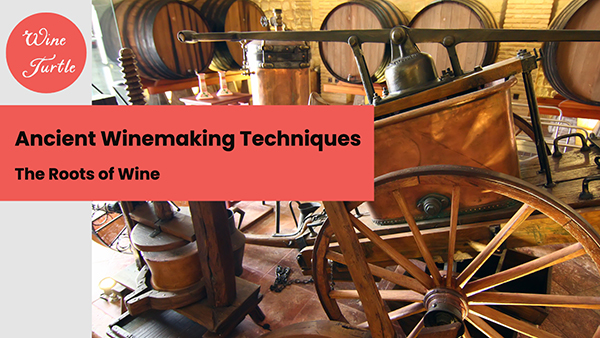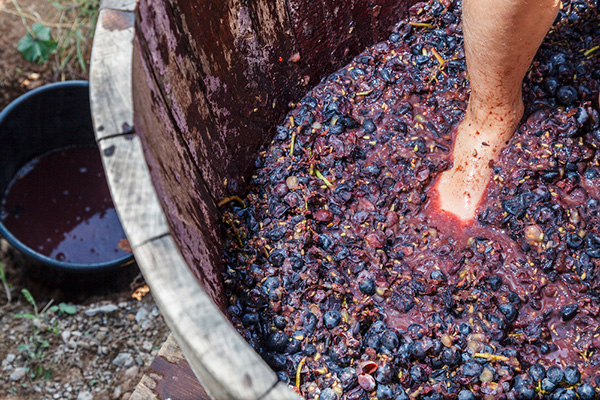Ancient Winemaking Techniques: The Roots of Wine

I've always been fascinated by the history of winemaking and how ancient techniques have shaped the modern wine industry.
Winemaking has been an integral part of human culture for thousands of years, and its origins can be traced back to the ancient civilizations of Mesopotamia, Egypt, and Greece.
In this guide, I will take you on a journey through time, exploring ancient winemaking techniques and sharing some personal insights along the way.
The Birth of Winemaking in Mesopotamia
The earliest evidence of grape domestication and wine production dates back to around 6000 BC in the Zagros Mountains of present-day Iran.
Excavations at the archaeological site of Hajji Firuz Tepe have uncovered wine jars containing residues of tartaric acid, a key component of grapes and wine, suggesting that our ancestors were already producing and consuming wine over 8,000 years ago.
Winemaking Techniques in Mesopotamia
The ancient Sumerians and Babylonians, who inhabited the fertile region between the Tigris and Euphrates rivers, developed some of the earliest known winemaking techniques.
They harvested grapes, crushed them with their feet, and fermented the juice in large clay vessels called amphorae. These vessels were often sealed with clay or pitch to prevent oxygen from entering and spoiling the wine.
Unfortunately, there's not much else we have to go on with regards to winemaking at this time. Rare evidence is so old that it's hard to get meaningful answers from it.

The Art of Winemaking in Ancient Egypt
The ancient Egyptians took winemaking to a new level, producing wines for religious ceremonies and as offerings to the gods and the deceased.
Wine played a significant role in ancient Egyptian culture, and it was often considered a luxury item reserved for the elite. Wine jars were frequently included in the tombs of the pharaohs, as it was believed that they would need sustenance in the afterlife.
Winemaking Techniques in Ancient Egypt
Egyptians had a more sophisticated approach to winemaking compared to their Mesopotamian counterparts.
One of the key techniques in Ancient Egyptian winemaking was the cultivation of grapevines. The Egyptians grew grapes in the fertile Nile Delta, where the soil was rich and the climate was suitable for viticulture.
They carefully selected the grape varieties and trained the vines to grow on trellises or other support structures, allowing better air circulation and sunlight exposure, which resulted in healthier grapes.
They used specially designed wine presses made of wood or stone to crush grapes, separating the juice from the skins and seeds more efficiently.
They also experimented with various fermentation techniques, such as using natural yeasts present on the grapes or adding cultivated yeasts to control the fermentation process. Fermentation took place in large ceramic jars known as amphorae or in more extensive basins made of stone or wood.
To age and store their wines, the Egyptians used sealed amphorae, which they often buried in the ground or placed in cool cellars. This method allowed the wine to mature and develop more complex flavors.
They would also use a variety of additives, such as honey, herbs, and tree resins, to enhance the taste and aroma of their wines.
The Golden Age of Winemaking in Ancient Greece
In ancient Greece, wine was an integral part of daily life and was often consumed at symposia, social gatherings where people would drink, discuss philosophy, and enjoy music and poetry.
The Greeks believed that the god Dionysus taught them the art of winemaking and worshiped him through elaborate rituals and festivities.
Wine also played a significant role in Greek mythology, with numerous stories involving the intoxicating effects of wine on gods and mortals alike.
Winemaking Techniques in Ancient Greece
Winemaking in Ancient Greece played a significant role in their society, culture, and economy. The Greeks were known to have advanced winemaking techniques, and their wines were well-regarded throughout the ancient world.
One of the notable techniques in Ancient Greek winemaking was the careful cultivation of vines. The Greeks were meticulous about selecting the right grape varieties and locations for their vineyards.
They focused on the quality of the soil, the angle of the sun, and the climate to create ideal conditions for growing vines. The Greeks were also known for their pruning techniques, which helped them control grape yield and improve the quality of the grapes.
In terms of equipment, the Greeks used large earthenware jars, known as pithoi, for fermenting and storing wine. These jars were partially buried in the ground, which helped to maintain a stable temperature during fermentation. The grape juice would be poured into the pithoi, and natural yeasts present on the grapes' skins would initiate fermentation.
Another essential aspect of Greek winemaking was the use of a wine press, known as the lenos. The lenos was a shallow stone basin with a low rim, and grapes were placed inside it for pressing. Workers would tread on the grapes with their feet to extract the juice, which would flow into a smaller container or directly into the pithoi for fermentation.
After fermentation, the Greeks would sometimes age their wines in amphorae, which were smaller ceramic vessels with a narrow neck and two handles. These amphorae were sealed with a layer of resin or pitch to preserve the wine and prevent spoilage. The Greeks often added various flavorings and additives to their wines, such as honey, herbs, and spices, to enhance the taste and aroma.
Ancient Greeks also used a technique called aeration to improve the wine's flavor profile. This involved pouring the wine from one container to another, allowing it to mix with air and develop more complex flavors. The Greeks believed that aeration could help to refine and mature the wine, making it more enjoyable to drink.
They also introduced the practice of blending wines from different grape varieties to create more balanced and harmonious flavors .
Roman Winemaking Techniques
The Romans played a significant role in the development of winemaking techniques, many of which are still in use today. As the Roman Empire expanded, so did their knowledge of viticulture and winemaking, incorporating practices from the cultures they conquered.
One of the key aspects of Roman winemaking was their meticulous approach to vineyard selection and cultivation. They understood the importance of terroir, considering factors such as soil type, sun exposure, and elevation when choosing where to plant their vineyards.
The Romans also practiced advanced viticultural techniques, such as grafting and pruning, to improve grape quality and yield.
Like earlier civilizations, the Romans used foot treading to crush the grapes, releasing the juice that would eventually become wine.
After treading, they would employ a pressing method using a wooden device known as the "torcular," which was an improvement upon earlier Greek and Egyptian presses. The torcular allowed for more efficient and controlled pressing, resulting in higher-quality juice extraction.
The Romans also experimented with various fermentation techniques. In some cases, they used large clay amphorae, which were partially buried in the ground to maintain a consistent temperature during fermentation.
They often sealed the amphorae with pitch or resin to prevent air exposure and spoilage, a practice still used in some modern winemaking regions.
Another significant innovation in Roman winemaking was the use of aging in wooden barrels, specifically oak. Oak barrels allowed for controlled oxidation and imparted desirable flavors and textures to the wine.
The use of oak also made it easier to transport wine, as the barrels were more durable and easier to handle than clay amphorae.
Roman winemakers were known to experiment with various additives and flavorings in their wines. They would often mix their wines with honey, herbs, or spices to enhance the taste and mask any flaws in the wine.
One popular additive was a mixture of seawater and grape juice called "defrutum," which was used to increase the sweetness and complexity of the wine.
The Romans were responsible for expanding the practice of wine production throughout their empire, particularly in regions such as Gaul (modern-day France) and Hispania (modern-day Spain).
They introduced new grape varieties and winemaking techniques to these regions, laying the groundwork for the diverse and vibrant wine cultures that exist there today.
Ancient Georgian Traditional Qvevri Winemaking Method
The ancient Georgian traditional Qvevri wine-making method is a unique and ancient technique dating back over 8,000 years. It was recognized by UNESCO as an Intangible Cultural Heritage of Humanity in 2013.
This method is named after the Qvevri, a large, egg-shaped earthenware vessel that is used for fermenting, aging, and storing wine.
The process begins with the harvesting of grapes, which are typically hand-picked to ensure the quality of the fruit. Once the grapes are gathered, they are brought to the marani, a traditional Georgian wine cellar.
Here, the grapes are pressed, usually by foot, to extract the juice, and the grape skins, stalks, and seeds, also known as pomace, are included in the fermentation process.
The Qvevri is then buried in the ground up to its neck, which helps maintain a stable temperature for fermentation and aging. The grape juice and pomace mixture is poured into the Qvevri, and the vessel is sealed with a wooden or stone lid. A layer of wet clay or beeswax may be added around the edges to create an airtight seal.
Fermentation begins naturally, without the addition of yeast, and it can last for several weeks. The unique shape of the Qvevri, combined with the presence of the grape skins, seeds, and stalks, encourages the solids to settle to the bottom while the juice ferments above. The fermentation process produces carbon dioxide, which forms a protective layer over the wine, minimizing the risk of oxidation.
Once fermentation is complete, the Qvevri is opened, and the wine is separated from the pomace. The wine is then decanted into another Qvevri for further aging or bottled for consumption. The pomace left behind can be distilled into a spirit called chacha or used as compost.
Wines produced using the Qvevri method are known for their rich, amber color, and unique flavor profile, characterized by tannins, earthiness, and a nutty, honeyed quality. This method is still used today in Georgia, and it has inspired a resurgence of interest in natural and ancient winemaking techniques around the world.
Conclusion
The ancient winemaking techniques developed by the Mesopotamians, Egyptians, Romans and Greeks laid the foundation for the modern wine industry we know today.
As we've explored in this article, these early civilizations played a significant role in shaping the art of winemaking through their innovative methods and deep appreciation for wine.
I find it fascinating to see how the ancient techniques have evolved over time and influenced the diverse range of wines we enjoy today.
From the simple foot-crushing of grapes in Mesopotamia to the sophisticated fermentation and aging processes of ancient Greece, these early winemakers were truly pioneers in their field.
By understanding the rich history of winemaking, we can better appreciate the efforts and expertise that goes into producing the fine wines we enjoy today.
So, the next time you raise a glass of wine, take a moment to reflect on the thousands of years of history and tradition that have led to the creation of that delicious beverage.
Cheers to the ancient winemakers who paved the way for the incredible wines we savor today!
